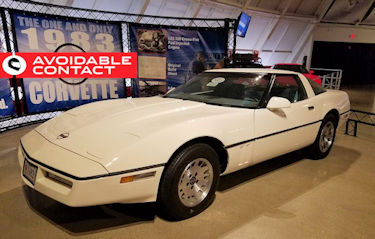World's Only 1983 Corvette
You don't need to be a Corvette fan to visit, and enjoy, the National Corvette Museum outside Bowling Green, Kentucky. It's a frequent destination for automotive fanatics of all stripes, from the Goodguys crowd to the various Midwestern Porsche and BMW regional clubs that use it as a destination for their back-road driving events. I've also personally witnessed a few road-to-Damascus moments at the museum in which people who are indifferent or even personally hostile to the crossed-flags sports car marque find themselves converted by the sheer volume of enthusiasm visible and audible from the moment you walk through the door.

One important aspect of that enthusiasm is that the NCM, unlike similar museums in Stuttgart and elsewhere, is not owned and operated by the manufacturer being honored within. It was the passion project of various people within the National Corvette Restorers Society, pursued on a bootstrap basis for over a decade before the necessary funding and assistance was secured. Most of the cars you'll find inside were donated or loaned by private individuals, although General Motors has also provided vehicles which could not be found anywhere else-like the Corvette Indy concept car and an early C5 crash-test example.
Oh, and they also handed over the world's last surviving 1983 Corvette.
It's only been 36 years since the Corvette wearing VIN 1G1AY0783D5110023 left the pilot assembly line and reported for duty at the GM Milford Proving Grounds, but the story of its escape, survival, and restoration has already acquired the misty sheen of a legend or fable. There were just 14 C4 prototypes and 43 "pilot cars" made in 1983, all of which were marked for destruction after the completion of testing. That's standard practice in the industry, and it's why you don't see, for example, pre-production Chevrolet Uplanders taking up space in your local buy-here-pay-here lot.
Corvettes aren't Uplanders, though, so this particular car was either "set aside"(according to some sources) or deliberately hidden (according to others) after the end of testing. About two years later, the plant manager found the car in the parking lot and had it moved into the plant. It was given a stars-and-stripes paint job and a set of directional 16-inch 1984-model wheels, all of which stayed on the car until it was donated to NCM to celebrate the museum's grand opening in 1994. At that point it was restored to plain white with a blue interior and the 15-inch wheels that had originally been designed for base-model C4s, before GM decided to fit all models with 16-inch wheels and Goodyear Gatorback tires.
Source - Jack Baruth - Road & Track
Posted 12/13/19